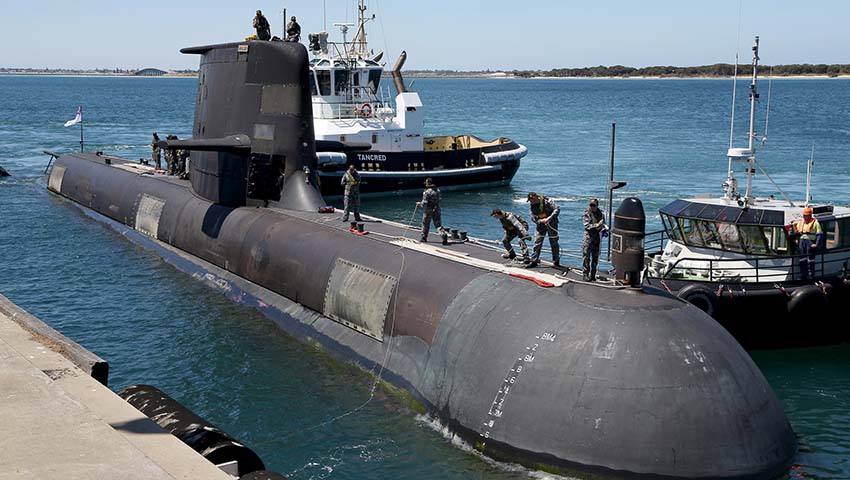Should the Commonwealth government invest in the construction of a new Collins Class submarine to fill a potential capability gap ahead of the promised SSN fleet?
To continue reading the rest of this article, please log in.
Create free account to get unlimited news articles and more!
The Commonwealth government’s Nuclear-Powered Submarine Task Force is currently consulting with stakeholders in the US and UK to devise a strategy for the procurement of nuclear-powered submarines for the Royal Australian Navy under the AUKUS agreement.
The group’s considerations include requirements for design, construction, maintenance, infrastructure, industry capacity, nuclear safety, environmental protection, crewing and training.
The Task Force will also advise on building timeframes, costs and supply needs.
Last October, Chief of Navy Vice Admiral Michael Noonan told the Senate foreign affairs, defence and trade legislation committee he expected at least one nuclear-powered submarine to be operational before 2040 under the “worst case scenario”.
To ensure the RAN’s undersea warfare capabilities are assured ahead of the delivery of the SSNs, the government invested $6 billion in a life-of-type extension (LOTE) of all six currently operating Collins Class submarines.
The LOTE is expected to keep the fleet operations until the 2050s.
However, Defence is not considering procuring an interim undersea platform to fill potential capability gaps and reduce dependence on the ageing Collins Class vessels.
Secretary of Defence Greg Moriarty told the same committee last year the government would instead focus on enhancing capability across all warfighting domains.
“The department is looking to identify further additional non-submarine capabilities to provide us with range of capabilities including offensive strike, long-range strike, offensive cyber,” he said.
Local bases are also expected to support US and UK SSN operations, with the government promising upgrades to HMAS Stirling and the construction of a new base along the east coast.
But according to Peter Briggs, a retired submarine specialist and a past president of the Submarine Institute of Australia, the government should consider the local manufacture of an interim capability to avoid an industry workforce “valley of death”.
Briggs welcomes the plan to procure nuclear-powered submarines, but flags risks associated with the long delivery timeline for full operational capability.
“The date we should be looking at is when we might have a fully operational SSN capability that can be deployed in harm’s way, to defend Australia,” he writes in ASPI’s The Strategist.
“That is a vastly different and more challenging set of requirements.”
This, he explains, means replacing the Collins Class capability with a submarine force supported by an industrial and logistical base capable of deploying two boats “in harm’s way” and “under Australian sovereign control”.
He claims six SSNs would be required to achieve this capability.
Given the three-year interval between each boat — the time needed to raise and train the next crew — he estimates it would take at least 15 years after the first SSN is commissioned to achieve the six-boat target.
If adding an additional three years for final work-up following the delivery of the sixth SSN, FOC could take up to 18 years.
“The Collins capability took much longer to deliver, something the navy should learn from,” Briggs continues.
Preparing trained crews to man the submarines could be a “critical path” to determining the delivery timeline, with Briggs estimating the Royal Australian Navy could have 600–720 personnel in seagoing crews.
Further, a spare crew of approximately 20 per submarine would be required to provide operational relief and ensure fully crewed boats for deployment.
This would lead to a total submarine arm of 2,160–2,520 if it represents three times the number of personnel at sea.
“This is two to three times the current size of the RAN’s submarine arm,” Briggs observes.
He goes on to reference Defence’s ‘Capability life cycle manual’, which notes the need for an operational capability to meet nine requirements of the ‘fundamental inputs to capability’.
For SSNs, this would include the “sovereign ability to support the submarines with intelligence”, enabled by high data-rate and discrete satellite communications.
The future nuclear-powered submarines would also need to be capable of targeting Tomahawk missiles.
“Based on the Royal Navy and UK regulatory approach, a sovereign support and supervisory capability for the RAN will include uniformed personnel, additional civilian regulators in the Australian Nuclear Science and Technology Organisation and the Australian Radiation Protection and Nuclear Safety Agency, and an industrial workforce,” he writes.
“They must be overseen by an independent verification and audit capability. How many trained and experienced people to support six SSNs are we talking about?”
Briggs estimates this would require 500 trained, experienced and certified personnel.
“Fleet Base West near Perth will house both Collins and SSNs at this stage, since there won’t be time to generate the additional 200 nuclear-experienced personnel required for a second submarine squadron on the east coast,” Briggs writes.
“Building a base is the first step; training the experienced personnel to man it will be another and the critical path.”
According to Briggs, Fleet Base West would require additional security and certified docking, ship-lift, tug and crane facilities.
Security measures could include local air defence against drones, seaward defences and surveillance systems for protection against mines and intruders.
In light of these drags on the SSN delivery timeline, Briggs argues the RAN would need additional conventional submarines to “cover the long transition time” and avoid the “risks and costs” of a second Collins Class LOTE.
He claims an increase to the conventional submarine fleet would also enable the RAN to spare personnel for nuclear training, providing experience for production pipelines while also sustaining an operational Collins Class capability.
As such, Briggs recommends the government initiate preparations for the construction of an updated Collins Class submarine in Adelaide.
“This program would have the additional benefits of re-establishing a submarine-building capability in Australia prior to building SSNs, exploiting the preparations that were being made for the now-cancelled Attack Class and avoiding a Defence and industry workforce ‘valley of death’,” he concludes.
Get involved with the discussion and let us know your thoughts on Australia’s future role and position in the Indo-Pacific region and what you would like to see from Australia's political leaders in terms of partisan and bipartisan agenda setting in the comments section below, or get in touch with
Charbel Kadib
News Editor – Defence and Security, Momentum Media
Prior to joining the defence and aerospace team in 2020, Charbel was news editor of The Adviser and Mortgage Business, where he covered developments in the banking and financial services sector for three years. Charbel has a keen interest in geopolitics and international relations, graduating from the University of Notre Dame with a double major in politics and journalism. Charbel has also completed internships with The Australian Department of Communications and the Arts and public relations agency Fifty Acres.

 Login
Login








